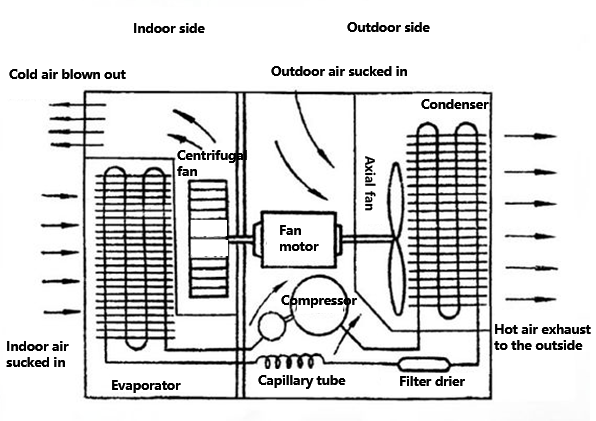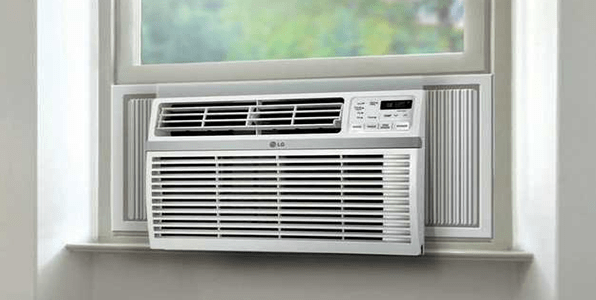
Figure 1: window AC unit.
Window air conditioning units are popular choices for cooling individual rooms or small spaces. Understanding how these units work can help you make informed decisions about their installation and maintenance.
In this article, we will delve into the mechanics of window AC units and explore the key components that enable them to provide efficient and effective cooling. From the refrigeration cycle to airflow management, we will cover all the essential aspects to give you a comprehensive understanding of how these units operate.
1. The Basics of Window AC Units
Window air conditioners, also known as window AC units, are compact cooling systems designed to cool a single room or a small area. These units consist of several important components integrated into a single housing. They are typically installed in windows or through wall openings.
1.1 Composition of Window AC Units
The compressor used in the window air conditioner is a hermetic (reciprocating or rotary) compressor, and the heat exchangers, including an evaporator and a condenser, are mainly composed of copper tubes and aluminum fins. The condenser is air-cooled. The throttling of the refrigerant is performed by capillary tube (or expansion valve).
It adopts multi-blade low-noise centrifugal fan (indoor) and axial flow fan (outdoor), and the two fans are driven by one motor. The air filter is made of non-woven fabric or chemical fiber. The controller is composed of an air volume control knob, temperature control knob and ventilation switch.

Figure 2: Internal structure of window air conditioner.
1.2 Key Aspects to Understand about Window AC Units
The following are the key aspects to understand about window AC units:
Cooling Capacity: Window AC units come in different cooling capacities, measured in British Thermal Units (BTUs). Choosing the right BTU rating depends on the size of the space you want to cool.
Single-Unit Design: Unlike central air conditioning systems, window AC units are self-contained and have all the necessary components integrated into a single housing. This makes them easy to install and more affordable compared to other cooling options.
Energy Efficiency: Many modern window AC units come with energy-efficient features such as programmable thermostats, sleep mode, and energy-saving settings. These features help optimize energy consumption and reduce utility costs.
2. Working Principle of Window AC Units
2.1 Refrigeration Cycle
The cooling process in window AC units is based on the refrigeration cycle, which involves the circulation and phase changes of a refrigerant. The refrigeration cycle can be explained in the following steps:
Evaporator Coil: The process begins with the evaporator coil, located inside the unit. As warm room air passes over the coil, the refrigerant inside absorbs heat and evaporates, cooling the air in the process.
Compressor: The gaseous refrigerant, having absorbed the heat, is then compressed by the unit's compressor. Compression increases the refrigerant's temperature and pressure, preparing it for the next stage.
Condenser Coil: The hot, compressed refrigerant flows to the condenser coil located on the outside of the unit. As outdoor air passes over the condenser coil, the heat is released, causing the refrigerant to condense back into a liquid state.
Expansion Valve: The liquid refrigerant, still under high pressure, passes through the expansion valve, which regulates the flow of refrigerant into the evaporator coil. As the refrigerant enters the evaporator coil, the cycle starts again with the absorption of heat from the room air.

Figure 3: Working principle diagram of window air conditioner.
2.2 Airflow and Temperature Control
Achieving efficient cooling in a room depends on managing the airflow and temperature control. Window AC units incorporate the following features to optimize these factors:
● Air Intake and Exhaust: Window AC units have vents and louvers that allow cooled air to enter and hot air to be expelled.
● Filters: Most window AC units are equipped with filters that trap dust, pollen, and other particles, improving indoor air quality. Regular cleaning or replacement of these filters is crucial for maintaining proper airflow and maximizing cooling efficiency.
● Thermostat: A built-in thermostat allows you to set and control the desired temperature in the room. Once the room reaches the desired temperature, the compressor cycles off until the temperature rises again. This helps maintain a comfortable and consistent cooling level.
● Fan Speeds: Most window AC units offer multiple fan speed options. You can adjust the fan speed to control the airflow and cooling intensity according to your preferences.
● Directional Airflow: Louvers or adjustable vents in window AC units allow you to direct the cooled air in a specific direction, optimizing the cooling effect in the room. Properly adjusting the airflow can help evenly distribute cool air and eliminate any hot spots.

Figure 4: Window AC unit.
3. Installation and Maintenance
Proper installation and regular maintenance are essential for the optimal performance and longevity of window AC units. Consider the following aspects when installing and maintaining your unit:
Proper Installation: Correct installation of a window AC unit is crucial for its efficient and safe operation. Follow the manufacturer's instructions or consult a professional for installation. Ensure that the unit is securely mounted and properly sealed to prevent air leaks.
Regular Cleaning: Clean the filter regularly to maintain proper airflow and indoor air quality. Additionally, clean the exterior and interior surfaces of the unit to remove dust and debris. A clean unit operates more efficiently and provides better cooling performance.
Sealing and Insulation: Properly seal and insulate the gaps around the unit to prevent air leaks, drafts, and the entry of pests. This helps maintain the efficiency of the unit by keeping hot air out and cool air inside.
Professional Check-ups: Periodically schedule professional maintenance to ensure optimal performance and address any issues promptly. A professional technician can inspect the unit, check for refrigerant leaks, clean the coils, and make any necessary repairs.

Figure 5: Window AC installed through the wall.
4. Conclusion
Window AC units provide a convenient and efficient way to cool individual rooms or small spaces. Understanding their functioning mechanisms, including the refrigeration cycle, airflow management, and temperature control, enables you to make informed decisions about their installation, operation, and maintenance.
By choosing the right cooling capacity, ensuring proper installation, and performing regular cleaning and maintenance, you can enjoy a comfortable and cool environment throughout the hot summer months.
Related Info
Dehumidifier Compressor Hot: Reasons and FixesRefrigerated Display Case: Everything You Need to Know
Quick Fixes for AC Freezing up: Troubleshooting and Solutions
Why Does My AC Keep Freezing Up at Night?
Air Conditioner Line Frozen: Causes, Troubleshooting and Prevention Methods


